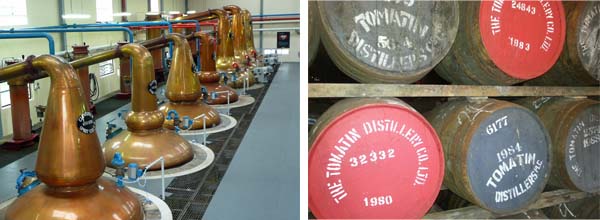

Whisky has been produced in Scotland for hundreds of years, although no one, even those involved with the Scotch Whisky Association, know quite exactly when it started. They do know that the ancient Celts might have been the precursors, because they distilled a liquid from barley that they called uisge beatha - the 'water of life' - a descriptor that has stayed with this most famous of spirit drinks to the current day.
While there are traditionally five types of whisky, there are two major categories familiar to the public - single, where all the constituent product is from one single distillery, and blended, where the constituent product is composed of whiskies from two or more distilleries. Single Malt Scotch whiskies, the envy of the world, are more expensive than their blended, yet often equally world-enviable counterparts.
Finally, in order to be referred to as "Scotch whisky", the composition and constituents of the spirit have to conform to the standards of the UK Scotch Whisky Order of 1990.
Following the Speyside Malt Whisky Trail is a highlight of many a holiday in Scotland - not only for whisky lovers! The Whisky Trail covers 7 working distilleries, a cooperage and a historic distillery and covers 74 miles - it's easily covered by car in 3 days and you will experience the beautiful Speyside countryside too. Find out about the history of whisky distilling, sample the drink and enjoy tours of some of the most fascinating distilleries in Scotland

We have put together a guide of Scottish Whisky Distilleries that are currently operating - you can use this aas aguide to help plan your own Whisky trail while visiting Scotland!
The Scottish distillery areas are as follows:
Speyside whisky tours - this area of Scotland has the largest number of distilleries - almost half of the country's - and includes some of the big names - Aberlour, Balvenie, Glenfiddich, Speyburn, The Glenlivet, The Glenrothes and The Macallan (the word "the" is used as a prefix in the titles). Whiskies from this region are said by experts to be "elegant, complex and, often with a refined smokiness".
Highland whisky trail - some Highland distilleries include Aberfeldy, Balblair, Dalmore, Dalwhinnie, Glen Ord, Glenmorangie, Oban and Old Pulteney. The whiskies produced in this region are noted for their "firm, round, dry character, with a little peatiness to stir the tastebuds".
Lowland - only three distilleries remain in operation: Auchentoshan, Bladnoch, and Glenkinchie. The whiskies from this region tend to be more "delicate with a mild and soft mellow nature".
Islay (silent 's') - this region is famed for the more heavy-bodied, smoky scotch varieties, often further described as "seaweedy and iodine-like with a hearty phenolic character". They provide the 'tang' to many blends. There are currently eight producing distilleries here: Ardbeg, Bowmore, Bruichladdich, Bunnahabhain, Caol Ila, Lagavulin, Laphroaig and Kilchoman.
The Islands, is more of an unofficial 'sub-region' and includes all of the whisky producing islands (but not Islay). Whiskies from here include Arran, Highland Park, Isle of Jura, Tobermory, Scapa, and the incredible Talisker from the islands of Arran, Jura, Mull, Orkney and Skye.
Campbeltown, was once home to some 34 distilleries, but currently has only three distilleries operating today, Glen Scotia, Glengyle (only recently opened) and Springbank. Springbank holds the record as the oldest independent distillery in Scotland. Unusually, Springbank, produces two different single malts, one being lightly peated while the other is somewhat smokier kilning in the other. Campbeltown single malts tend to have a briny character.
If visiting a distillery, you need to check whether it is open at the time of your expected arrival, and what the visitor policy is for each individual distillery. Many will require you to book in advance.